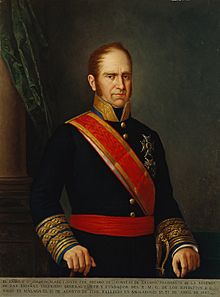Battle of Baza (1810) facts for kids
Quick facts for kids Battle of Baza (1810) |
|||||||
|---|---|---|---|---|---|---|---|
| Part of Peninsular War | |||||||
 Joaquín Blake was beaten when he let his corps get spread out. |
|||||||
|
|||||||
| Belligerents | |||||||
| Commanders and leaders | |||||||
| Strength | |||||||
| 3,300 | 9,000 12 guns |
||||||
| Casualties and losses | |||||||
| 200 | 1,500 6 guns |
||||||
The Battle of Baza took place on November 4, 1810. It was a fight between French forces, led by General Édouard Jean Baptiste Milhaud, and Spanish troops, commanded by General Joaquín Blake y Joyes. This battle was part of the Peninsular War, which was itself a part of the larger Napoleonic Wars.
The Spanish commander, General Blake, made a mistake by letting his soldiers spread out too much. General Milhaud saw this chance and attacked with his cavalry (soldiers on horseback). They quickly defeated Blake's front line, causing many losses for the Spanish. After the battle, the Spanish army had to retreat into the Murcia province. Baza is a town in Spain, located about 80 kilometers (50 miles) north of Almería.
After King Joseph Bonaparte's army took control of Andalusia, they had a lot more land to protect. French Marshal Nicolas Soult had to keep his soldiers busy defending against constant threats from Spanish and British forces. At Baza, the French successfully pushed back one Spanish attack. A few months later, another important battle would happen at Barrosa.
Why the Battle Happened
On November 18 and 19, 1809, the main Spanish army suffered a huge defeat at the Battle of Ocaña. Just a week later, another Spanish army was beaten at the Battle of Alba de Tormes. Spain quickly tried to gather a new army to defend its southern regions.
King Joseph Bonaparte decided to invade the rich province of Andalusia. He wanted to add this wealthy area to his kingdom because his royal treasury was almost empty.
In January 1810, the French army moved into Andalusia. They quickly took control of most of the region in January and February 1810. However, they could not capture Cádiz, a city on an island. Cádiz bravely held out against the French for a very long time, from February 5, 1810, until August 25, 1812.
Soon after, Emperor Napoleon put Marshal Nicolas Soult in charge of Andalusia. Marshal Soult found it hard to defend this new territory because there were many threats. He had to spread his troops out to guard different borders. The British navy controlled the seas, which meant they could easily move British and Spanish soldiers to attack French-held places along the coast. One of these attacks, the Battle of Fuengirola on October 13, 1810, ended badly for the British.
The Battle of Baza
In August 1810, General Sébastiani's French troops reached the city of Murcia. But General Blake's Spanish soldiers had strong defenses around the city. Sébastiani also heard that Spanish fighters had captured two small ports in Andalusia and were close to Granada. So, Sébastiani quickly gave up trying to take Murcia and rushed back to protect Granada.
After staying near the border of Murcia and Andalusia for several weeks, General Blake decided to advance. On November 2, he moved forward with 8,000 foot soldiers and 1,000 cavalry. By November 3, the Spanish general had taken Cúllar and kept moving.
Blake made a critical mistake: he allowed his army to spread out too much. His front group, made up of cavalry and 3,000 foot soldiers, camped near Baza on the evening of November 3. Meanwhile, his rear group of 2,000 men stayed near Cúllar. His remaining soldiers were somewhere in between.
When General Milhaud heard about the Spanish advance, he quickly marched his cavalry to Baza. He arrived on the morning of November 4 and joined 2,000 French foot soldiers already in Baza.
The French forces included a brigade of infantry (foot soldiers) and Milhaud's cavalry division. This cavalry division had about 1,300 soldiers, including dragoons (soldiers who could fight on horseback or on foot) and Polish lancers (soldiers with long spears). The French also had two horse artillery batteries (cannons pulled by horses). The Spanish had 12 cannons, along with their infantry and cavalry.
Milhaud arranged his troops on both sides of the main road. He then ordered his cavalry to charge Blake's cavalry. The Spanish horsemen were quickly defeated and ran away. As they fled, they crashed into their own foot soldiers, causing confusion. When the French dragoons and Polish lancers attacked the surprised Spanish infantry, the Spanish soldiers scattered and fled.
Milhaud's cavalry completely defeated Blake's front group, killing many soldiers and capturing many prisoners. However, when the French met the second Spanish division, which was in rougher terrain, they decided not to attack. Blake immediately ordered his remaining forces to retreat back to Cúllar.
After the Battle
The French forces, led by Milhaud, lost about 200 soldiers who were either killed or wounded. All of these losses were among their cavalry. In return, they caused much greater damage to the Spanish army. The Spanish lost 500 soldiers killed or wounded, and the French captured 1,000 more. The Spanish also lost all 12 of their cannons.
General Blake returned to Murcia and stayed quiet for the rest of the year. The next major action in the area was the Battle of Barrosa on March 5, 1811. In that battle, British Lieutenant General Thomas Graham defeated a French army led by General Victor.
Images for kids




